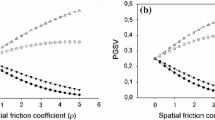Abstract
In spatial voting games without a core, if candidates are constrained on one issue, they are implicitly constrained on other issues. Thus external constraints affect optimal positions for candidates. Using new solution concepts, we find the optimal position for a candidate given any linear constraint, given an opponent’s constraint, and determine conditions when constraints are sufficient to yield unbeatable positions.
Similar content being viewed by others
References
Asay, G. R., & Saari, D. G. (2006). Why negative campaigning? The chaotic dynamics of an election. Unpublished working paper, Institute for Mathematical Behavioral Sciences.
Bernhagen, P. (2001). Why parties make a difference: Mandates, ideology and reputation in partisan politics. Unpublished working paper, Department of Political Science, Trinity College Dublin.
Black, D., & Newing, R. A. (1951). Committee decisions with complementary valuation. London: Lowe and Brydon.
Bradley, W. J., Hodge, J. K., & Kilgour, D. M. (2005). Separable discrete preferences. Mathematical Social Sciences, 49, 335–353.
Budge, I., Klingemann, H.-D., Volkens, A., Tannenbaum, E., & Bara, J. (2001). Mapping policy preferences: Estimates for parties, electors, and governments 1945–1998. Oxford: Oxford University Press.
Davis, O. A., & Hinich, M. J. (1966). In Mathematical model of policy formation in a democratic society. Mathematical Applications in Political Science, II (pp. 175–208). Dallas: The Arnold Foundation of Southern Methodist University.
Downs, A. (1957). An economic theory of democracy. New York: Harper and Row.
Enelow, J. M., & Hinich, M. J. (1982). Ideology, issues, and the spatial theory of elections. The American Political Science Review, 76(3), 493–501.
Enelow, J. M., & Hinich, M. J. (1984). Probabilistic voting and the importance of centrist ideologies in democratic elections. The Journal of Politics, 46(2), 459–478.
Enelow, J. M., & Hinich, M. J. (1989). A general probabilistic spatial theory of elections. Public Choice, 61, 101–113.
Ferejohn, J. A., McKelvey, R. D., & Packel, E. W. (1984). Limiting distributions for continuous state Markov models. Social Choice and Welfare, 1(1), 45–67.
Glazer, A., & Grofman, B. N. (1989). Why representatives are ideologists while voters are not. Public Choice, 61(1), 29–39.
Gorman, W. M. (1968). The structure of utility functions. The Review of Economic Studies, 35(4), 367–390.
Hinich, M. J., & Munger, M. C. (1994). Ideology and the theory of political choice. Ann Arbor: The University of Michigan Press.
Hinich, M. J., & Munger, M. C. (1997). Analytical politics. New York: The Cambridge University Press.
Hotelling, H. (1929). Stability and competition. The Economic Journal, 39(March), 41–57.
Laver, M. (1997). Private desires, political action: An invitation to the politics of rational choice. London: Sage.
McKelvey, R. D. (1979). General condidtions for global intransitivites in formal voting models. Econometrica, 47(September), 1085–1112.
Miller, N. R., & Hammond, T. H. (1990). Committees and the core. Public Choice, 66, 201–227.
Owen, G., & Shapley, L. S. (1989). Optimal location of candidates in ideological space. International Journal of Game Theory, 18, 339–356.
Plott, C. (1967). A notion of equilibrium and its possibility under majority rule. American Economic Review, 57(4), 787–806.
Riccardi, N. (2006). From welcome to wary in Utah’. Los Angeles Times, April 30, 2006, 13.
Saari, D. G. (1997). The generic existence of a core for Q-rules. Economic Theory, 9(56), 219–260.
Saari, D. G. (2004). Geometry of chaotic and stable discussions. Mathematical Monthly, May, 377–393.
Saari, D. G., & Asay, G. R. (2006). Finessing a point; augmenting a core. Unpublished working paper, University of California, Irvine.
Shepsle, K. A., & Weingast, B. (1984). Uncovered sets and sophisticated voting outcomes with implications for agenda institutions. American Journal of Political Science, 28, 49–74.
Tullock, G. (1981). Why so much stability. Public Choice, 37(January), 189–205.
Wuffle, A., Feld, S. L., Owen, G., & Grofman, B. (1989). Finagle’s law and the finagle point, a new solution concept for two-candidate competition in spatial voting. American Journal of Political Science, 33(2), 348–375.
Author information
Authors and Affiliations
Corresponding author
Rights and permissions
About this article
Cite this article
Beeler Asay, G.R. How does ideology matter in the spatial model of voting?. Public Choice 135, 109–123 (2008). https://doi.org/10.1007/s11127-007-9241-2
Received:
Accepted:
Published:
Issue Date:
DOI: https://doi.org/10.1007/s11127-007-9241-2




